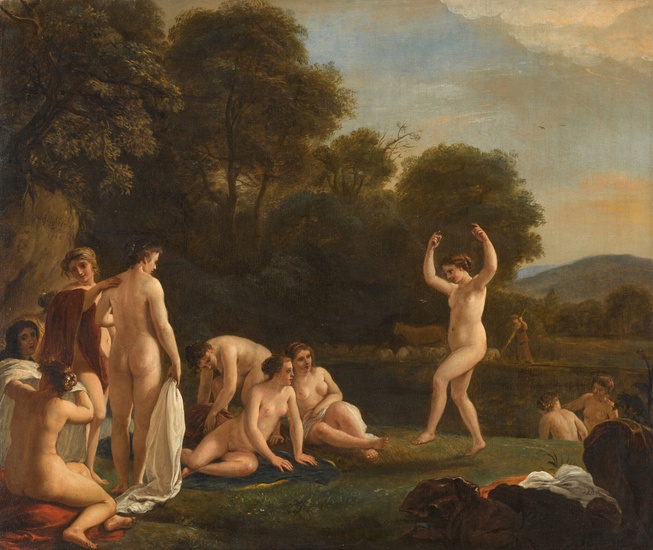Cornelis Holsteyn Diana and her nymphs
Cornelis Holsteyn
Haarlem 1618–1658 Amsterdam
Diana and her nymphs
signed and dated centre left edge: CHolsteyn / 1654
oil on canvas
unframed: 73.6 x 86.4 cm.; 29 x 34 in.
framed: 89 x 102 cm.; 35 x 40⅛ in.
Condition Report:
The canvas has been lined and is providing a stable support. The surface is slightly dirty and the varnish has yellowed in some areas. There is a diagonal surface mark running from the trees, across the upper half of the dancing figure. Minor frame rubbing to the extremities of the canvas. Inspection under ultraviolet light reveals three horizontal fine lines of retouching running from the left hand edge, two of which stop in the centre section, the third smaller. Further retouching to the majority of the figures, the extremities of the canvas, smaller touches to the sky, the trees and the background. Overall the work appears to be in fairly good condition.
Catalogue Note:
Cornelis Holsteyn belonged to a group of painters from Haarlem that included Salomon and Jan de Bray and Pieter de Grebber, known today as the Haarlem Classicists. Holsteyn moved to Amsterdam in 1647, probably drawn by the demand there for large-scale history painting, acquiring citizenship in 1652. 1654, the year of this painting, seems to have been something of an annus mirabilis for Holsteyn. He became engaged, and he and Machteltje Cornelisdr. Holsblock, who was two years his senior, posted their banns on 24 December. Earlier that year he painted the ceiling and overmantel of the Orphan Chamber of the new Amsterdam Town Hall (now the Royal Palace), a commission met with success that yielded further similar large-scale commissions for Amsterdam public buildings. Holsteyn’s career ended prematurely when he died in late autumn 1658, aged 40. His brief flourishing as a history painter – his first major commission other than for portraiture was in Haarlem in 1647 – probably explains why his work is so rare today. This painting is strongly Italianate in character, with an Arcadian setting inspired by Claude. One must suppose that Holsteyn had seen the Italianate paintings of the Utrecht painters of direct Roman experience such as Breenbergh and Poelenbergh, of whose small-scale panels with female nudes this is an up-scaling, as well as engravings of Claude Lorrain’s works, but the facial types here are distinctive: characteristic of Holsteyn himself, and closer to his Haarlem peers than to anyone from further afield.
Provenance:
Anonymous sale, London, Christie's, 14 November 1958, lot 62, for 30 guineas, to Dent;
Dr Ephraim I. Schapiro (1899–1977), London;
By whose Executors sold ('The Property of the late Dr E. I. Schapiro sold by order of the executors'), London, Christie's, 13 July 1979, lot 18;
Anonymous sale, London, Christie's, 11 December 1986, lot 24, for £3,500.
View it on
Sale price
Estimate
Time, Location
Auction House
Cornelis Holsteyn
Haarlem 1618–1658 Amsterdam
Diana and her nymphs
signed and dated centre left edge: CHolsteyn / 1654
oil on canvas
unframed: 73.6 x 86.4 cm.; 29 x 34 in.
framed: 89 x 102 cm.; 35 x 40⅛ in.
Condition Report:
The canvas has been lined and is providing a stable support. The surface is slightly dirty and the varnish has yellowed in some areas. There is a diagonal surface mark running from the trees, across the upper half of the dancing figure. Minor frame rubbing to the extremities of the canvas. Inspection under ultraviolet light reveals three horizontal fine lines of retouching running from the left hand edge, two of which stop in the centre section, the third smaller. Further retouching to the majority of the figures, the extremities of the canvas, smaller touches to the sky, the trees and the background. Overall the work appears to be in fairly good condition.
Catalogue Note:
Cornelis Holsteyn belonged to a group of painters from Haarlem that included Salomon and Jan de Bray and Pieter de Grebber, known today as the Haarlem Classicists. Holsteyn moved to Amsterdam in 1647, probably drawn by the demand there for large-scale history painting, acquiring citizenship in 1652. 1654, the year of this painting, seems to have been something of an annus mirabilis for Holsteyn. He became engaged, and he and Machteltje Cornelisdr. Holsblock, who was two years his senior, posted their banns on 24 December. Earlier that year he painted the ceiling and overmantel of the Orphan Chamber of the new Amsterdam Town Hall (now the Royal Palace), a commission met with success that yielded further similar large-scale commissions for Amsterdam public buildings. Holsteyn’s career ended prematurely when he died in late autumn 1658, aged 40. His brief flourishing as a history painter – his first major commission other than for portraiture was in Haarlem in 1647 – probably explains why his work is so rare today. This painting is strongly Italianate in character, with an Arcadian setting inspired by Claude. One must suppose that Holsteyn had seen the Italianate paintings of the Utrecht painters of direct Roman experience such as Breenbergh and Poelenbergh, of whose small-scale panels with female nudes this is an up-scaling, as well as engravings of Claude Lorrain’s works, but the facial types here are distinctive: characteristic of Holsteyn himself, and closer to his Haarlem peers than to anyone from further afield.
Provenance:
Anonymous sale, London, Christie's, 14 November 1958, lot 62, for 30 guineas, to Dent;
Dr Ephraim I. Schapiro (1899–1977), London;
By whose Executors sold ('The Property of the late Dr E. I. Schapiro sold by order of the executors'), London, Christie's, 13 July 1979, lot 18;
Anonymous sale, London, Christie's, 11 December 1986, lot 24, for £3,500.



